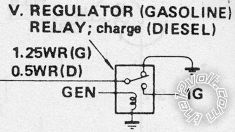Posted: January 10, 2011 at 10:11 AM / IP Logged
Posted: January 10, 2011 at 10:35 PM / IP Logged
Posted: January 11, 2011 at 1:03 PM / IP Logged
Posted: January 11, 2011 at 1:59 PM / IP Logged
Posted: January 12, 2011 at 2:08 PM / IP Logged
Posted: January 12, 2011 at 5:20 PM / IP Logged
Posted: January 12, 2011 at 5:47 PM / IP Logged
Sorry, you can NOT post a reply.
This topic is closed.
 Printable version
Printable version


| You cannot post new topics in this forum You cannot reply to topics in this forum You cannot delete your posts in this forum You cannot edit your posts in this forum You cannot create polls in this forum You cannot vote in polls in this forum |

| Search the12volt.com |
Follow the12volt.com 
Sunday, November 23, 2025 • Copyright © 1999-2025 the12volt.com, All Rights Reserved • Privacy Policy & Use of Cookies


Sunday, November 23, 2025 • Copyright © 1999-2025 the12volt.com, All Rights Reserved • Privacy Policy & Use of Cookies
Disclaimer:
*All information on this site ( the12volt.com ) is provided "as is" without any warranty of any kind, either expressed or implied, including but not limited to fitness for a particular use. Any user assumes the entire risk as to the accuracy and use of this information. Please
verify all wire colors and diagrams before applying any information.









 (From Chilton's else similar references; the LHS "output" goes to the charge-Lamp's ground and can supply +12V to energise N.C. fuel cut valves, or N.O. fuel-pump relays, auto-chokes and idle-solenoids etc, or headlight or load or battery isolators etc.)
It is commonly used to control electric fuel pumps on older vehicles, and UIBIs (Ultimate Intelligence Battery Isolators) by modern clever people, etc.
But BEWARE - the charge lamp (else other parallel lamps or resistances) are usually required to supply a tickle or trickle current to ENSURE the alternator initiates charging. (Otherwise the alternator relies on remnant rotor magnetism to start charging, though some regulators will simply not initiate without this trickle current (eg - Bosch S&L types).)
The other issue is alternator type & vintage.
Older external electo-mech regulators have no problems sinking lamp currents or sourcing relay currents.
Electronic regulators (external or internal) can usually sink an Amp or two, and usually supply and Amp or two, but it isn't guaranteed. (EG - most alternators from the 1970s thru 1990s would sink an Amp or two from dash bulbs.)
Modern vehicles may have low-current or asymmetric interfaces - use a transistor, FET or MOSFET instead else as a buffer.
Or they may be EMS interactive in which case any charge lamp "circuit" is used instead (ie, lamp on when NOT charging as with normal charge lamps), else ANYTHING that changes state when charging or not charging (eg voltage or current sensing circuits).
It sounds difficult but it isn't. It is only the changing technology since vehicle generators wee introduce that changes HOW we use that information - ie, that the system is charging.
(From Chilton's else similar references; the LHS "output" goes to the charge-Lamp's ground and can supply +12V to energise N.C. fuel cut valves, or N.O. fuel-pump relays, auto-chokes and idle-solenoids etc, or headlight or load or battery isolators etc.)
It is commonly used to control electric fuel pumps on older vehicles, and UIBIs (Ultimate Intelligence Battery Isolators) by modern clever people, etc.
But BEWARE - the charge lamp (else other parallel lamps or resistances) are usually required to supply a tickle or trickle current to ENSURE the alternator initiates charging. (Otherwise the alternator relies on remnant rotor magnetism to start charging, though some regulators will simply not initiate without this trickle current (eg - Bosch S&L types).)
The other issue is alternator type & vintage.
Older external electo-mech regulators have no problems sinking lamp currents or sourcing relay currents.
Electronic regulators (external or internal) can usually sink an Amp or two, and usually supply and Amp or two, but it isn't guaranteed. (EG - most alternators from the 1970s thru 1990s would sink an Amp or two from dash bulbs.)
Modern vehicles may have low-current or asymmetric interfaces - use a transistor, FET or MOSFET instead else as a buffer.
Or they may be EMS interactive in which case any charge lamp "circuit" is used instead (ie, lamp on when NOT charging as with normal charge lamps), else ANYTHING that changes state when charging or not charging (eg voltage or current sensing circuits).
It sounds difficult but it isn't. It is only the changing technology since vehicle generators wee introduce that changes HOW we use that information - ie, that the system is charging.